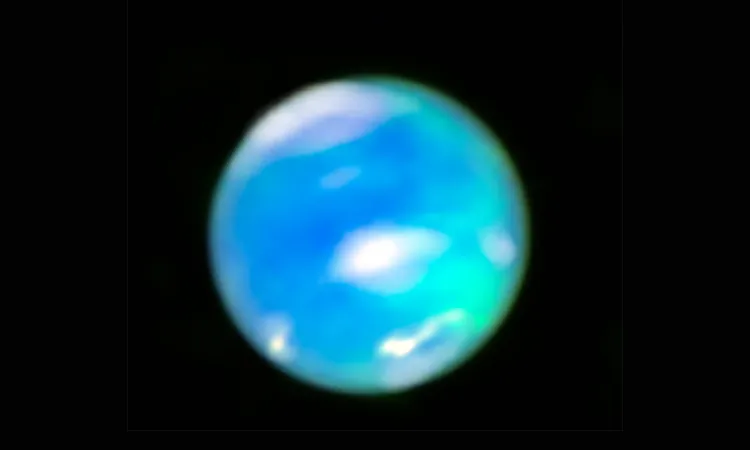
Stunning Discovery: James Webb Telescope Reveals Neptune's Auroras for the First Time!
2025-03-30
Author: Sarah
For the first time in history, the elusive auroras of Neptune have been vividly captured, thanks to NASA’s groundbreaking James Webb Space Telescope (JWST). This monumental achievement allows astronomers to witness the dynamic auroral activity illuminating Neptune's upper atmosphere.
The newly obtained data reveal that energetic particles, primarily originating from the Sun, travel through Neptune's magnetic fields, colliding with the planet's atmosphere. This interaction generates a stunning glowing effect that has now been documented in the near-infrared images produced by Webb.
Neptune’s Auroras: A Long-Awaited Revelation
Though the Voyager 2 spacecraft hinted at the presence of auroras on Neptune during its 1989 flyby, conclusive evidence remained elusive for decades. While other massive gas giants like Jupiter, Saturn, and Uranus have had their auroras imaged, Neptune kept its secrets hidden until now.
According to lead researcher Henrik Melin from Northumbria University, the ability to finally visualize Neptune’s auroras was a feat only achievable due to Webb's exceptional near-infrared capabilities. "The clarity and detail of the auroras were truly astonishing," he remarked.
In June 2023, Webb utilized its Near-Infrared Spectrograph to capture these groundbreaking images. In addition to auroras, astronomers gathered vital spectral data that allowed them to analyze the atmospheric temperature and chemical composition of Neptune.
The Significance of H3+ Molecule
One of the most exciting discoveries from Webb's observations was the clear identification of a strong emission line from H3+, a molecule known to form during auroras. Previously, H3+ has proven to be a reliable indicator of auroral activity among gas giants. This was a crucial moment for researchers, as they had long anticipated its detection on Neptune but had failed with past observational techniques.
Heidi Hammel, an interdisciplinary scientist at the Association of Universities for Research in Astronomy (AURA) and leader of the Guaranteed Time Observation program, stated, “Seeing H3+ confirmed in our spectra was the culmination of years of effort.”
Unraveling Neptune’s Unique Magnetic Field
Neptune presents fascinating complexity in terms of its magnetic field. Unlike Earth’s auroral displays that occur near the poles, Neptune's auroras manifest in mid-latitudes. This peculiar observation ties back to Voyager 2's finding: Neptune’s magnetic field is tilted at an angle of 47 degrees relative to its rotation axis, causing auroras to radiate much farther away from expected polar regions.
These insights into Neptune’s magnetic behavior will aid scientists as they explore how solar particles interact with the planet's distant magnetic fields, further unraveling the intricacies of space weather effects on gas giants.
A Chilling Revelation: Neptune’s Cooling Atmosphere
The data from Webb also unveiled a startling trend — Neptune's upper atmosphere has undergone significant cooling since it was last studied in 1989. Melin expressed shock at this finding, noting that temperatures have dropped by several hundreds of degrees, with the current atmospheric temperature now just over half of what it was decades ago.
This colder atmospheric environment likely accounts for the previously undetected auroral activity, shedding light on the dynamic and complex nature of Neptune's atmosphere, even while located over 30 astronomical units from the Sun.
The Future of Neptune Exploration
These unprecedented findings usher in a new era for ice giant exploration. Scientists now aim to conduct continuous observations of Neptune over a complete solar cycle (approximately 11 years) to track how changes in solar activity impact the planet.
Leigh Fletcher, a co-author of the study, emphasized the necessity of utilizing infrared instruments for future missions to Uranus and Neptune: “Webb has opened a window into previously unexplored territories of the giant planets' ionospheres,” he said.
The results of this groundbreaking research have been published in the esteemed journal Nature Astronomy, indicating that future studies could further unveil the mysteries surrounding our solar system's outer worlds.
Conclusion
Neptune's auroras have finally been confirmed, showcasing the power of advanced space telescopes and providing a deeper understanding of one of our solar system's most enigmatic planets. This discovery not only enhances our knowledge of Neptune but also sets the stage for exciting explorations to come!



 Brasil (PT)
Brasil (PT)
 Canada (EN)
Canada (EN)
 Chile (ES)
Chile (ES)
 Česko (CS)
Česko (CS)
 대한민국 (KO)
대한민국 (KO)
 España (ES)
España (ES)
 France (FR)
France (FR)
 Hong Kong (EN)
Hong Kong (EN)
 Italia (IT)
Italia (IT)
 日本 (JA)
日本 (JA)
 Magyarország (HU)
Magyarország (HU)
 Norge (NO)
Norge (NO)
 Polska (PL)
Polska (PL)
 Schweiz (DE)
Schweiz (DE)
 Singapore (EN)
Singapore (EN)
 Sverige (SV)
Sverige (SV)
 Suomi (FI)
Suomi (FI)
 Türkiye (TR)
Türkiye (TR)
 الإمارات العربية المتحدة (AR)
الإمارات العربية المتحدة (AR)